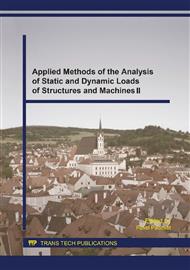[1]
M. Riedl et al., Zpráva o stavu lesa a lesního hospodářství České republiky za rok 2013, Ministerstvo zemědělství, Praha, (2014).
Google Scholar
[2]
O. Ševců, J. Vinař, M. Pacáková, Metodika ochrany dřeva, Jalna, Praha, (2000).
Google Scholar
[3]
D. Bousquet, Lumber Drying: An Overview of Current Processes, University of Vermont Extension, Vermont, (2000).
Google Scholar
[4]
B. A. Jayne, Mechanical properties of wood fibers, Tappi 42 (1959) 41-46.
Google Scholar
[5]
R. Wimmer et al., Longitudinal Hardness and Elastic Stiffness of Spruce Tracheid Secondary Walls Using Nanoindentation Technique, Wood Science and Technology 31 (1997) 31-141.
DOI: 10.1007/bf00705928
Google Scholar
[6]
R. Wimmer , B. N. Lucas, Comparing mechanical properties of secondary wall and cell corner middle lamella in spruce wood, IAWA 18 (1997) 77-88.
DOI: 10.1163/22941932-90001463
Google Scholar
[7]
Z. Prošek et al., Microstructure Description and Micromechanical Properties of Spruce Wood, Acta Polytechnica 55 (2015) 39-49.
DOI: 10.14311/ap.2015.55.0039
Google Scholar
[8]
Z. Prošek et al., Micromechanical Properties of Spruce Tissues Using Static Nanoindentation and Modulus Mapping, Applied Mechanics and Materials 732 (2015) 115-118.
DOI: 10.4028/www.scientific.net/amm.732.115
Google Scholar
[9]
L. Xiaodong, B. Bharat, A review of nanoindentation continuous stiffness measurement technique and its applications, Materials Characterization 48 (2002) 11-36.
DOI: 10.1016/s1044-5803(02)00192-4
Google Scholar
[10]
P. Klapálek, L. Melzerová, Methods of non-destructive assessment of timber, Applied Mechanics and Materials 732 (2015) 369-372.
DOI: 10.4028/www.scientific.net/amm.732.369
Google Scholar


